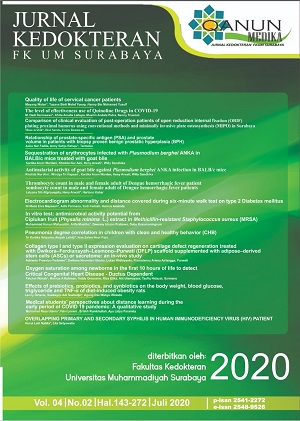Thrombocyte Count in Male and Female Adult of Dengue Hemorrhagic Fever Patients
Abstrak
Abstract
The trend of dengue virus infection in Indonesia has changed from children to older groups. Some studies suggested that different gender might affect the different progression of dengue infection, but its mechanism was unclear. This study analyzed the difference by evaluating the daily thrombocyte count pattern. An analytic observational study with a retrospective design was conducted using the secondary data collected from medical records in Dr. Soetomo General Hospital Surabaya during 2017-2018. The samples were adult patients in the age range of 18-55 years old with DHF but without comorbidity or coinfection. The total number of samples was 40 patients. The average of thrombocyte count in both male and female patients decreased since the 3rd day of illness and reached the lowest level on the 6th day of illness then increased on the 7th day but did not reach the normal range. Although the majority of thrombocyte count in females was lower than males, there was no significant difference in thrombocyte count pattern between them.
Â
Keyword: Adult, DHF, Thrombocyte, Gender
Correspondence : heny-a@fk.unair.ac.id
Artikel teks lengkap
Referensi
Aamir, M., Masood, G., Aamir, W., Rasheed, A., & Ejaz, A. (2014). Gender Difference in patients with Dengue Fever admitted in a Teaching Hospital , Lahore. 8(1), 12–15.
CDC National Center for Emerging and Zoonotic Infectious Diseases. (2012). Dengue and the Aedes aegypti Mosquito, Centers for Disease Control and Prevention. 1–2.
Fairweather, D., & Frisancho-kiss, S. (2008). Sex Differences in Autoimmune Disease from a Pathological Perspective. 600–609. https://doi.org/10.2353/ajpath.2008.071008
Greenwood D, Slack R., Barer M, Irving, W. (2012). Medical Microbiology A guide to Microbial Infections (19th ed.). British: Elsevier.
Haryanto, B. (2018). We are IntechOpen , the world ’ s leading publisher of Open Access books Built by scientists , for scientists TOP 1 %. Intech Open Access Book.
Huy, N. T., Giang, T. Van, Ha, D., Thuy, D., Kikuchi, M., &
Hien, T. T. (2013). Factors Associated with Dengue Shock Syndrome : A Systematic Review and Meta-Analysis. 7(9). https://doi.org/10.1371/journal.pntd.0002412
Jawetz, E., Melnick, JL., &Adelberg, E. (2016). Jawetz,
Melnick&Adelberg’s medical microbiology (27th ed.). New York: McGraw-Hill Medical.
Jones, B. G., Sealy, R. E., Penkert, R. R., Surman, S. L.,
Maul, R. W., Neale, G., … Hurwitz, J. L. (2018). Complex sex-biased antibody responses : estrogen receptors bind estrogen response elements centered within immunoglobulin heavy chain gene enhancers. 31(3), 141–156. https://doi.org/10.1093/intimm/dxy074
Kanda, N., & Tamaki, K. (1999). Estrogen enhances immunoglobulin production by human PBMCs. 282–288.
Kanda, N., Tsuchida, T., & Medicine, F. (1996). Testosterone inhibits immunoglobulin production by human peripheral blood mononuclear cells. 410–415.
Karyanti, M. R., Uiterwaal, C. S. P. M., Kusriastuti, R.,
Hadinegoro, S. R., Rovers, M. M., Heesterbeek, H., …
Bruijning-Verhagen, P. (2014). The changing incidence of Dengue Haemorrhagic Fever in Indonesia: A 45-year registry-based analysis. BMC Infectious Diseases, 14(1), 1–7. https://doi.org/10.1186/1471-2334-14-412
Kuo, H., Lee, I., & Liu, J. (2018). ScienceDirect Analyses of clinical and laboratory characteristics of dengue adults at their hospital presentations based on the World Health Organization clinical-phase framework : Emphasizing risk of severe dengue in the elderly. Journal of Microbiology, Immunology and Infection, 51(6), 740–748. https://doi.org/10.1016/j.jmii.2016.08.024
Lam, P. K., Ngoc, T. Van, Thi, T., Thuy, T., Van, N. T. H., Thi, T., … Wolbers, M. (2017). The value of daily platelet counts for predicting dengue shock syndrome : Results from a prospective observational study of 2301 Vietnamese children with dengue. 143, 1–20.
Mubarak, A., Alghasali, H. S., & Bahashwan, A. A. (2017). iMedPub Journals Dengue Related Deaths at Ibn-Sina Hospital- Al-Mukalla : Causes and Alarming Signals. 1–7. https://doi.org/10.21767/2472-1093.100037
Murray, Rosenthal, P. (2016). Medical Microbiology (8th ed.). Canada: Elsevier.
Payyappilly, R. J., Karunakaran, U., & Adilat, D. (2017). Dimorphism in response of sexes to dengue infection modifying course and outcome of disease. 4(2), 47–55.
Raza, F. A., Rehman, S., Khalid, R., Ahmad, J., Ashraf, S.,
Iqbal, M., & Hasnain, S. (2014). Demographic and Clinico-Epidemiological Features of Dengue Fever in Faisalabad , Pakistan. 9(3), 5–11. https://doi.org/10.1371/journal.pone.0089868
RI, K. (2016). Data dan Informasi Profil Kesehatan Indonesia. In Data dan Informasi Profil Kesehatan Indonesia.
Ruggieri, A., Anticoli, S., Ambrosio, A. D., Giordani, L., &
Viora, M. (2016). The influence of sex and gender on immunity , infection and vaccination. 52(2), 198–204. https://doi.org/10.4415/ANN
Sari, R. C., Kahar, H., & Puspitasari, D. (2017). Pola Jumlah Trombosit Pasien Infeksi Virus Dengue yang Dirawat di SMF Ilmu Kesehatan Anak RSUD Dr. Soetomo Surabaya. 19(1), 1–6.
Sharma, Y., Jain, S., Kumar, M., Deka, L., & Mathur, A. (2014). Dengue and Typhoid Co-infection – Study from a Government Hospital in North Delhi. 10–12. https://doi.org/10.7860/JCDR/2014/9936.5270
Werneck, G. L., Macias, A. E., Mascarenas, C., Coudeville, L., Morley, D., Recamier, V., … Toh, M. (2018). Comorbidities increase in-hospital mortality in dengue patients in Brazil. 113(8), 1–5. https://doi.org/10.1590/0074-02760180082
WHO. (2011). Prevention and Control of Dengue and Dengue Haemorrhagic Fever.
WHO Media Centre. (2017). Dengue and Severe Dengue Fact Sheet. Retrieved April 18, 2018, from http://www.who.int/mediacentre/factsheets/fs117/en/
Penulis

Qanun Medika oleh FK UM Surabaya disebarluaskan di bawah Lisensi Creative Commons Atribusi 4.0 Internasional.
Berdasarkan ciptaan pada http://journal.um-surabaya.ac.id/index.php/qanunmedika.

